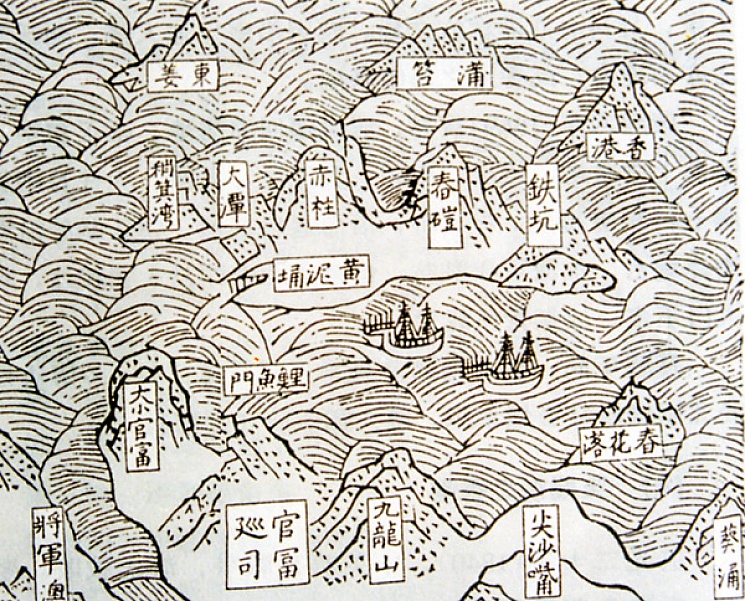Contemporary Hong Kong is a multi-faceted city. Historically, the place and name that is Aberdeen (Little Hong Kong) is equally complicated. From what we can gather, the beginning of Aberdeen has to do with its traditional industry, the policy of the Ming and Qing Dynasties, as well as the surveying mission of foreign marine fleets.
a.Official Records of Ming and Qing Dynasties
What we know as “Hong Kong” today was a small, nameless island. The geographic records of the Ming and Qing Dynasties named part of its hills and villages, but never the entire island. The name “Hong Kong” first appeared in Yue Daji (1595) of the Ming Dyansty, which referred to today’s Ap Lei Chau. Two hundred years later, the name “Hong Kong Ts’un” (Hong Kong Village) appeared in Xinan Xianzhi (1819) of the Qing Dyansty. Hong Kong Ts’un – one of the namesakes for Hong Kong – is also the name for today’s Wong Chuk Hang Old Village.
The question is: how did the Hong Kong Village come about?
b.Shek Pai Wan and the Fragrant Wood Trade
In fact, Shek Pai Wan in the Ming Dynasty was a busy port for the trade of fragrant wood, a form of incense used in the Guangdong area. The fragrant wood trade connected Shek Pai Wan to Baoan and Dongguan. Fragrant wood from the neighbouring regions were gathered at Shek Pai Wan, before being shipped to Guangdong, Jiangsu, and Zhejiang. At its height, the trade of fragrant wood in Shek Pai Wan amounted to ten thousand taels of silver per annum. Situated on the north of Shek Pai Wan, Hong Kong Village was closely related to the fragrant wood trade. This explained the name “Hong Kong”, which means “port of fragrance”.
The Great Clearance by the Qing Emperor in 1661 devastated the incense trade in Hong Kong Village. The edict ordered all residents along the Canton coast to burn their homes and move inland for at least 15km. The Great Clearance was only abolished in 1683. Around a century later, Hong Kong Village was re-established near today’s Wong Chuk Hang.
The question is: how did “Hong Kong” go on to become the name of the entire island? And how did Aberdeen come about?
c.The Story of “Port Independence”
Situated between Ap Lei Chau and Aberdeen, Aberdeen Harbour is a natural haven for incoming ships. A few hundred years ago, the three waterfalls in Aberdeen provided a steady source of fresh water for its villagers and boat people. As early as the 16th century, the Portuguese Felix Mendoza already visited Aberdeen. In 1792, the American John Kendrick made a visit to Aberdeen Harbour with “Lady Washington”. He was provided with fresh water, supplies, and even pinewood for ship repairs. In his delight, John Kendrick named the harbour “Port Independence”. John Kendrick was subsequently killed in an accident in Hawaii, and his maritime records later fell into the hands of English hydrographer Alexander Dalrymple.
The name of “Port Independence” was soon forgotten, but Aberdeen became a haven for English and East India Company ships. The Amherst Embassy visited Aberdeen for supplies on their way to Beijing. Drawn by William Harvell in 1817, “The Waterfall at Hong Kong” depicts Aberdeen from a seafarer’s point of view. The gushing waterfall, mountain terrains and small huts housed the imagination of a generation of colonizers.
In the Macao Roads (1810) map drawn by Daniel Ross and Philip Maughan, the name “Hong Kong” designated the entire island for the first time. The Map of the San On District (1866) drawn by Italian missionary Simeon Volonteri also designates the island as “Hong Kong”. As for Aberdeen, Thomas Collinson’s map of Hong Kong in 1845 marked the village in Wong Chuk Hang as “Heong Kong”, it was changed to “Little Hong Kong” in the government maps of 1898. The English name “Aberdeen” was chosen in honour of George Hamilton-Gordon, 4th Earl of Aberdeen. Nowadays, the entire area between Wah Fu Estate and Wong Chuk Hang is loosely understood as Aberdeen.
From “Port Independence” to “Little Hong Kong”, Aberdeen is a microcosm of Hong Kong history. Aberdeen today boasts a unique coastline, and is home to tens of thousands of Hong Kongers.
References:
Davies, Stephen. “Daniel Ross, John Kendrick and Aberdeen”.
----. “Port Independence”.
林準祥。Re-examining the Origin of "Hong Kong"「重新檢視「香港」英文名字的由來」。(http://www.master-insight.com/content/article/5825/page/1/1?nopaging=1)
蘇子夏(編)。Hong Kong Geography《香港地理:山海依舊風物在》。香港:商務印書館有限公司,2015。
梁炳華。The Heritage of Southern District《南區風物志》。香港:南區區議會,2009。
蕭國健。Essays on Hong Kong's Early History《探本索微——香港早期歷史論集》。香港 : 中華書局有限公司,2015。






